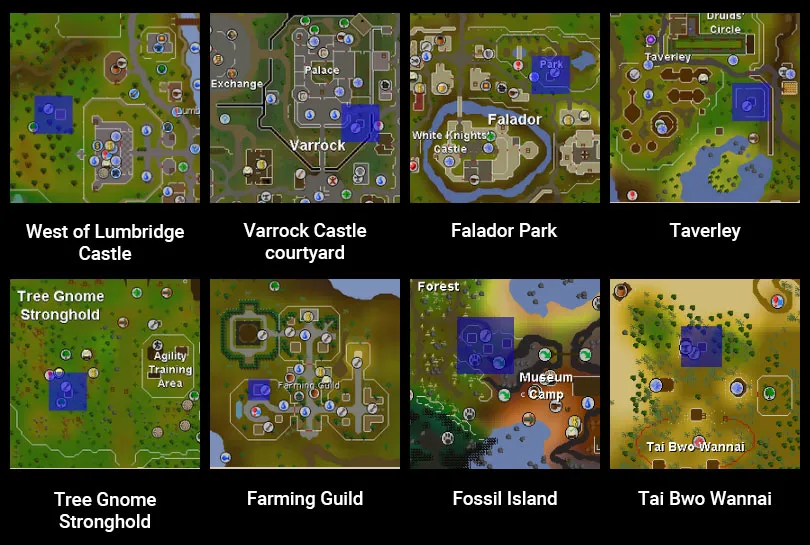Your cart is empty
How to Convert Logs to Planks in OSRS: A Comprehensive Guide

In Old School RuneScape (OSRS), logs are essential resources used in various crafting and construction activities. Players can convert logs into planks, which serve as building materials for various structures, including furniture and houses in the Player Owned House (POH) system. Understanding the process of converting logs to planks is crucial for players looking to enhance their construction skills and create functional spaces within the game. This guide will cover the basics of logs and planks, as well as the different types of logs available for conversion.
In OSRS, there are several types of logs that players can convert into planks, each with varying requirements and uses. The primary types of logs are:
- Normal Logs: These are the most basic type of logs and can be obtained by chopping regular trees. They are commonly used in early construction projects and require no special tools for conversion. Players can convert normal logs into planks at a sawmill for a fee of 1 coin per log.
- Oak Logs: Oak logs are obtained from oak trees and provide better experience for construction compared to normal logs. To convert oak logs into oak planks, players must visit the sawmill, which charges 2 coins per log. Oak planks are often used for building more advanced furniture and structures in the POH.
- Willow Logs: Chopped from willow trees, these logs are favored for their higher experience yield and faster chopping speed. Willow logs can be converted into willow planks at the sawmill for 3 coins each. These planks are useful for creating medium-tier furniture, allowing players to further enhance their housing options.
- Teak Logs: Obtained from teak trees, these logs are more valuable and provide a better construction experience. The conversion cost at the sawmill is 4 coins per log. Teak planks are popular for building high-quality furniture and are essential for players looking to maximize their construction level.
- Mahogany Logs: Mahogany logs are the most advanced type of logs and are harvested from mahogany trees. They are more challenging to obtain but yield high experience and are essential for top-tier furniture. The conversion fee is 6 coins per log, and mahogany planks are highly sought after for their aesthetic appeal and practical uses in construction.
Each type of log has its unique benefits and costs associated with converting to planks. Players should consider their current construction goals and resources when choosing which logs to convert. Knowing the differences can help in planning your construction projects effectively.
3. Understanding the Sawing Process

Converting logs to planks in Old School RuneScape (OSRS) is a straightforward process, but understanding the sawing mechanics can make it even easier. When you approach a sawmill, you’ll encounter a few key steps that dictate how this conversion works.
First, it is essential to find a sawmill. The most popular locations are:
- *Varrock Sawmill: Located southeast of Varrock, it is the most frequented sawmill.
- Sawmill in the Lumberyard: This location is near the trees and is convenient for those training Woodcutting.
Once you have your logs and have arrived at the sawmill, the sawing process begins. Here’s a step-by-step overview:
- Interact with the Sawmill Operator: Approach the Sawmill and click on the sawmill operator to start the process.
- Select Logs: After talking to the operator, you will have the option to choose which type of logs you want to convert. The options typically include regular logs, oak logs, willow logs, and more.
- Pay the Fee: Converting logs incurs a small fee based on the type and number of logs you wish to saw. Be sure you have enough coins!
- Receive Planks: Once the payment is made, the sawing process completes, and you’ll receive planks in exchange for your logs.
And that’s it! Now you know how to efficiently convert your logs into planks. Remember, the type of logs you use will determine the type of planks you receive and their associated crafting experience.
4. Required Tools for Converting Logs to Planks
Before diving into the process of converting logs to planks, it’s crucial to have the right tools at your disposal. Fortunately, the requirements are minimal, making this task accessible for many players.
Here’s what you’ll need:
- Logs: Obviously, you need logs to convert. The type of logs you have will dictate the type of planks you will receive.
- Coins: As mentioned earlier, converting logs to planks costs money. Make sure you have enough coins in your inventory.
- Optional – Woodcutting Equipment: While not required for the conversion itself, having an axe can help you gather logs more efficiently. Depending on your level, you can choose from various axes, such as a bronze axe or a rune axe.
- Optional – Sawmill Operator’s Favor*: Although not a tangible item, having a good relationship with the sawmill operator can sometimes result in quicker service.
In summary, the main requirements for converting logs to planks in OSRS are logs and coins. With these two essentials, you can easily access the sawing process and start crafting planks for your construction projects. Happy sawing!
Step-by-Step Guide to Converting Logs to Planks
Converting logs to planks in Old School RuneScape (OSRS) is a straightforward process, but it does require a few steps and the right tools. Follow this step-by-step guide to ensure you get it right!
- Gather Your Logs: Start by collecting the logs you want to convert. You can chop down trees or purchase logs from other players or the Grand Exchange.
- Locate a Sawmill: Head to the Sawmill located in the Woodcutting Guild or the one in Varrock. Both places allow you to convert your logs into planks.
- Check Your Inventory: Make sure you have the logs in your inventory. You cannot convert planks if your inventory is full, so leave some space.
- Interact with the Sawmill Operator: Speak to the Sawmill Operator. You can do this by right-clicking on him and selecting the option to convert your logs.
- Select Your Logs: Choose the type and amount of logs you want to convert. The Sawmill Operator will let you know how many planks you can get in return.
- Confirm the Conversion: After selecting your logs, confirm the conversion. You will receive planks in exchange for your logs, and your logs will be removed from your inventory.
That’s it! You’ve successfully converted your logs into planks. It’s a simple yet effective way to start your carpentry journey.
Experience Gains from Converting Logs to Planks
Converting logs to planks in OSRS is not just about creating materials for construction; it also provides valuable experience points (XP) that can help you level up your Woodcutting and Construction skills.
| Type of Log | Plank Type | Experience Gained |
|---|---|---|
| Normal Log | Regular Plank | 35 XP |
| Oak Log | Oak Plank | 60 XP |
| Willow Log | Willow Plank | 90 XP |
| Teak Log | Teak Plank | 120 XP |
| Mahogany Log | Mahogany Plank | 150 XP |
As you can see from the table, the experience gained varies based on the type of log you are converting. This means that if you’re looking to maximize your XP gains, it’s worth investing time in gathering higher-level logs, like mahogany or teak. Not only will this help you level up faster, but it will also open up new crafting opportunities down the line.
So, get chopping and get converting! Your journey to becoming a master carpenter in OSRS starts with those logs.
Best Practices for Efficient Plank Making
Making planks from logs in OSRS can be a straightforward process, but there are some best practices that can help you maximize your efficiency. Here’s what you should keep in mind:
- Choose the Right Logs: Not all logs are created equal. Opt for logs that provide the highest experience and are readily available. Oak and teak logs are popular choices for efficient plank making.
- Use the Right Sawmill: Always use the sawmill located in the Woodcutting Guild or the one in Varrock. These locations tend to have fewer distractions and allow for quicker transactions.
- Bring a Hammer and Nails: Always carry a hammer and some nails in your inventory. Although they aren’t directly needed for converting logs to planks, they can be useful if you plan to build furniture or other items afterward.
- Utilize the Bank Efficiently: Make sure to bank your logs before heading to the sawmill. This way, you can quickly convert them into planks without wasting time.
- Plan Your Inventory: Fill your inventory with logs to make the process smoother. You can use a combination of logs for different plank types, but too many varieties can slow you down.
- Use the Right Skills: Consider boosting your Woodcutting and Construction skills before you start. Higher levels can lead to faster log gathering and plank making.
By following these best practices, you’ll be able to convert logs to planks more efficiently, helping you to further your progress in OSRS.
Common Mistakes to Avoid
While converting logs to planks may seem simple, there are some common pitfalls that players often encounter. Here are a few mistakes to avoid:
- Ignoring the Sawmill Fees: Players sometimes forget that there is a fee associated with converting logs to planks. Make sure you have enough coins to cover the cost, or you’ll find yourself stuck!
- Not Banking Logs: If you attempt to make planks without banking your logs first, you’ll lose valuable time running back and forth. Always plan ahead!
- Underestimating Log Types: Some players make the mistake of using logs that provide lower experience. Always consider the benefits of using higher-tier logs for better efficiency.
- Overloading Your Inventory: Carrying too many types of logs can slow you down. Stick to a few types to streamline the plank-making process.
- Forgetting to Use Bonuses: If you have any experience boosts or potions that can help, don’t forget to utilize them! They can significantly speed up your progress.
- Neglecting Your Skills: Some players overlook the importance of leveling up their Woodcutting and Construction skills. Higher levels contribute to faster log collection and plank conversion.
Avoiding these common mistakes will ensure that your time spent converting logs to planks is as efficient and enjoyable as possible. Happy skilling!
How to Convert Logs to Planks in OSRS: A Comprehensive Guide
In Old School RuneScape (OSRS), converting logs to planks is a crucial step for players looking to engage in construction or crafting. This guide provides a step-by-step approach to efficiently convert your logs into planks.
There are several methods to convert logs to planks:
- Using the Sawmill: The primary method is taking your logs to a sawmill.
- Using the Portable Sawmill: A more flexible option that can be set up anywhere.
- Hiring a Worker: You can hire a worker to convert logs for you at certain locations.
Using the Sawmill
The Sawmill is located in Varrock and is the most common place to convert logs into planks. Here’s how to use it:
- Travel to the Sawmill.
- Speak to the Sawmill operator.
- Select the type of logs you want to convert.
- Pay the required fee:
| Log Type | Plank Type | Cost |
|---|---|---|
| Normal Logs | Normal Plank | 100 coins |
| Oak Logs | Oak Plank | 250 coins |
| Willow Logs | Willow Plank | 500 coins |
| Teak Logs | Teak Plank | 1,000 coins |
| Mahogany Logs | Mahogany Plank | 1,500 coins |
Using the Portable Sawmill
The Portable Sawmill allows you to convert logs to planks on the go. You will need to have a Portable Sawmill in your inventory, which can be obtained via the Construction skill or purchased.
Simply place the sawmill and interact with it to convert your logs without any cost.
Hiring a Worker
Another alternative is to hire a worker, usually found near the sawmill. They will convert your logs for a fee, but the process is generally slower.
In summary, converting logs to planks in OSRS is straightforward. Utilizing the sawmill, portable sawmill, or hiring a worker offers various methods to suit your needs.
Conclusion: Maximizing Your Plank Production
To maximize your plank production, consider your location, available resources, and whether you prefer speed or cost-effectiveness when choosing a conversion method.

